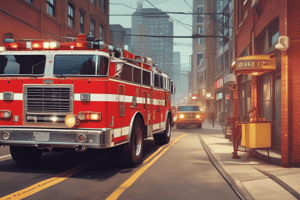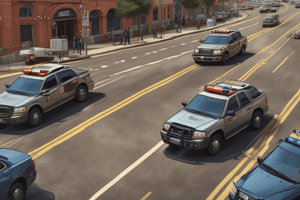Podcast
Questions and Answers
What is a primary function of the Safe Work Area in emergency situations?
What is a primary function of the Safe Work Area in emergency situations?
Which of the following describes an appropriate positioning for medical units within a Safe Work Area?
Which of the following describes an appropriate positioning for medical units within a Safe Work Area?
What is the purpose of positioning fire rescue apparatuses to protect specific areas from upstream traffic?
What is the purpose of positioning fire rescue apparatuses to protect specific areas from upstream traffic?
What should be included in the necessary components of a Safe Work Area?
What should be included in the necessary components of a Safe Work Area?
Signup and view all the answers
How should the patient transport vehicles loading area be positioned?
How should the patient transport vehicles loading area be positioned?
Signup and view all the answers
What does a multi-directional traffic pattern imply at an incident scene?
What does a multi-directional traffic pattern imply at an incident scene?
Signup and view all the answers
When establishing the Safe Work Area, what should be a key consideration for its size?
When establishing the Safe Work Area, what should be a key consideration for its size?
Signup and view all the answers
What is a critical role of law enforcement at an emergency scene?
What is a critical role of law enforcement at an emergency scene?
Signup and view all the answers
What should be considered when making the decision to stop and render assistance at an incident?
What should be considered when making the decision to stop and render assistance at an incident?
Signup and view all the answers
What is the primary safety concern when stopping to render assistance near moving traffic?
What is the primary safety concern when stopping to render assistance near moving traffic?
Signup and view all the answers
What is the recommended parking position for staff vehicles responding to an incident?
What is the recommended parking position for staff vehicles responding to an incident?
Signup and view all the answers
In what situation should a non-emergency staff vehicle be used as a block?
In what situation should a non-emergency staff vehicle be used as a block?
Signup and view all the answers
What must be done before personnel exit their vehicle at an incident?
What must be done before personnel exit their vehicle at an incident?
Signup and view all the answers
When using flares for warning, how far apart should they be placed?
When using flares for warning, how far apart should they be placed?
Signup and view all the answers
What is the furthest distance that a flare should be placed upstream from the incident?
What is the furthest distance that a flare should be placed upstream from the incident?
Signup and view all the answers
What is the significance of activating warning lights on vehicles at an incident scene?
What is the significance of activating warning lights on vehicles at an incident scene?
Signup and view all the answers
Which statement correctly describes the identification of shoulders in a traffic incident?
Which statement correctly describes the identification of shoulders in a traffic incident?
Signup and view all the answers
What is the primary purpose of blocking in traffic operations?
What is the primary purpose of blocking in traffic operations?
Signup and view all the answers
In traffic operations, how should the first arriving Fire Rescue apparatus be positioned?
In traffic operations, how should the first arriving Fire Rescue apparatus be positioned?
Signup and view all the answers
When should Fire Rescue apparatuses park on the same side of the roadway?
When should Fire Rescue apparatuses park on the same side of the roadway?
Signup and view all the answers
What should be done if the wheels of blocking Fire Rescue apparatuses are available?
What should be done if the wheels of blocking Fire Rescue apparatuses are available?
Signup and view all the answers
Which of the following demonstrates the correct approach to positioning a Fire Rescue apparatus at an incident?
Which of the following demonstrates the correct approach to positioning a Fire Rescue apparatus at an incident?
Signup and view all the answers
What is the correct way to indicate direction of travel at an incident location?
What is the correct way to indicate direction of travel at an incident location?
Signup and view all the answers
What is the primary goal of positioning Fire Rescue personnel and vehicles during an incident?
What is the primary goal of positioning Fire Rescue personnel and vehicles during an incident?
Signup and view all the answers
What is the primary purpose of the Lookout's warning to operating personnel?
What is the primary purpose of the Lookout's warning to operating personnel?
Signup and view all the answers
What defines a non-compliant motorist in the context provided?
What defines a non-compliant motorist in the context provided?
Signup and view all the answers
What is the function of the Transition Zone on a roadway?
What is the function of the Transition Zone on a roadway?
Signup and view all the answers
At what intervals should traffic cones be deployed upstream of the blocking apparatus?
At what intervals should traffic cones be deployed upstream of the blocking apparatus?
Signup and view all the answers
Which action should personnel take when placing and retrieving cones and flares?
Which action should personnel take when placing and retrieving cones and flares?
Signup and view all the answers
How can the effectiveness of nighttime operations be enhanced?
How can the effectiveness of nighttime operations be enhanced?
Signup and view all the answers
What is the role of cones in identifying transition and tapering actions?
What is the role of cones in identifying transition and tapering actions?
Signup and view all the answers
What might Law Enforcement do with traffic cones at the incident scene?
What might Law Enforcement do with traffic cones at the incident scene?
Signup and view all the answers
What should be done to manage the termination of an incident effectively?
What should be done to manage the termination of an incident effectively?
Signup and view all the answers
Which of the following is NOT a responsibility of the Incident Commander?
Which of the following is NOT a responsibility of the Incident Commander?
Signup and view all the answers
What should be maintained to ensure the safety of all personnel at an incident scene?
What should be maintained to ensure the safety of all personnel at an incident scene?
Signup and view all the answers
When managing traffic at an incident, what is the role of warning flares?
When managing traffic at an incident, what is the role of warning flares?
Signup and view all the answers
What should vehicle drivers do when tapering back into traffic after an incident?
What should vehicle drivers do when tapering back into traffic after an incident?
Signup and view all the answers
Which is a consideration when operating on high-volume limited access highways?
Which is a consideration when operating on high-volume limited access highways?
Signup and view all the answers
What action is necessary regarding emergency warning lights during an incident?
What action is necessary regarding emergency warning lights during an incident?
Signup and view all the answers
What is a necessary practice when parking patient transport vehicles at an incident?
What is a necessary practice when parking patient transport vehicles at an incident?
Signup and view all the answers
Study Notes
Shoulder Identification
- Shoulders are identified as "right/left" and "inside/outside" using the term "shoulder".
- Left shoulder is termed as inside shoulder; right shoulder is outside shoulder.
- Example: For southbound Interstate 95, use "inside (or left) shoulder".
Incident Communication
- Indicate the relative direction of travel (northbound or southbound) along with location details.
- Incoming units should be instructed on their blocking position, specifying lanes and shoulder positions.
Blocking Procedures
- Position Fire Rescue apparatus to protect personnel, law enforcement, tow operators, patients, and the public.
- Apparatus placement should slow and redirect approaching motorists.
- Where possible, emergency vehicles should park on the same side of the roadway.
- First arriving apparatus must provide blocking by positioning at a 45° angle to traffic lanes.
- Blocking should cover at least one additional lane impacted by a crash.
- Wheels of blocking apparatus should be chocked and turned away from the incident.
Safe Work Area
- Defined as the designated area for emergency personnel to operate safely on a roadway.
- Must be protected from traffic hazards and large enough to include:
- All damaged vehicles
- Roadway debris
- Patient triage and treatment areas
- Extrication work area
- Personnel and tools staging area
- Patient transport vehicle loading area angled away from traffic
Law Enforcement Coordination
- Provide clear traffic control directions to law enforcement officers present at the incident.
- Law enforcement vehicles can be used to block additional traffic lanes as necessary.
Multi-directional Traffic Patterns
- Multi-directional patterns involve traffic moving in various directions near the Safe Work Area.
- A Lookout must warn personnel of non-compliant motorists using a portable radio or audible signal.
Transition Zones and Tapering
- Transition Zones are lanes where upstream motorists adjust speed and lane positions.
- Tapering merges several traffic lanes into fewer lanes.
- Traffic cones should be placed from the blocking apparatus toward upstream traffic, spaced 15 feet apart.
Incident Termination
- Manage the termination with the same precautions as initiation, removing units promptly from the roadway to minimize traffic congestion and exposure.
- Notify law enforcement before leaving the incident to allow for vehicle repositioning.
Incident Command Considerations
- The Incident Commander must ensure a Safe Work Area is established and maintained, and all personnel wear high-visibility reflective vests.
- Designate parking locations for all arriving units and ensure emergency lights remain activated.
High-Volume Highway Operations
- Special considerations apply on high-volume limited access highways like Florida’s Turnpike and Interstate 95.
- Decisions to stop for assistance should be based on reasonable and prudent assessments.
- Relocate uninjured persons to the Safe Work Area away from moving traffic whenever possible.
- Vehicles must be positioned to ensure the highest safety for rescue personnel and the public.
Safety Equipment Usage
- Use safety vests before exiting vehicles.
- Flares should be deployed at 15-foot intervals upstream of the incident, with the furthest flare placed approximately 75 feet away for adequate warning.
Studying That Suits You
Use AI to generate personalized quizzes and flashcards to suit your learning preferences.
Related Documents
Description
This quiz focuses on the correct identification and terminology used by responders in emergency situations regarding the shoulders of roads. It emphasizes the importance of directional clarity in incident reporting, particularly when referring to 'inside/outside' shoulders and relative directions of travel. Test your understanding of these critical terms.




